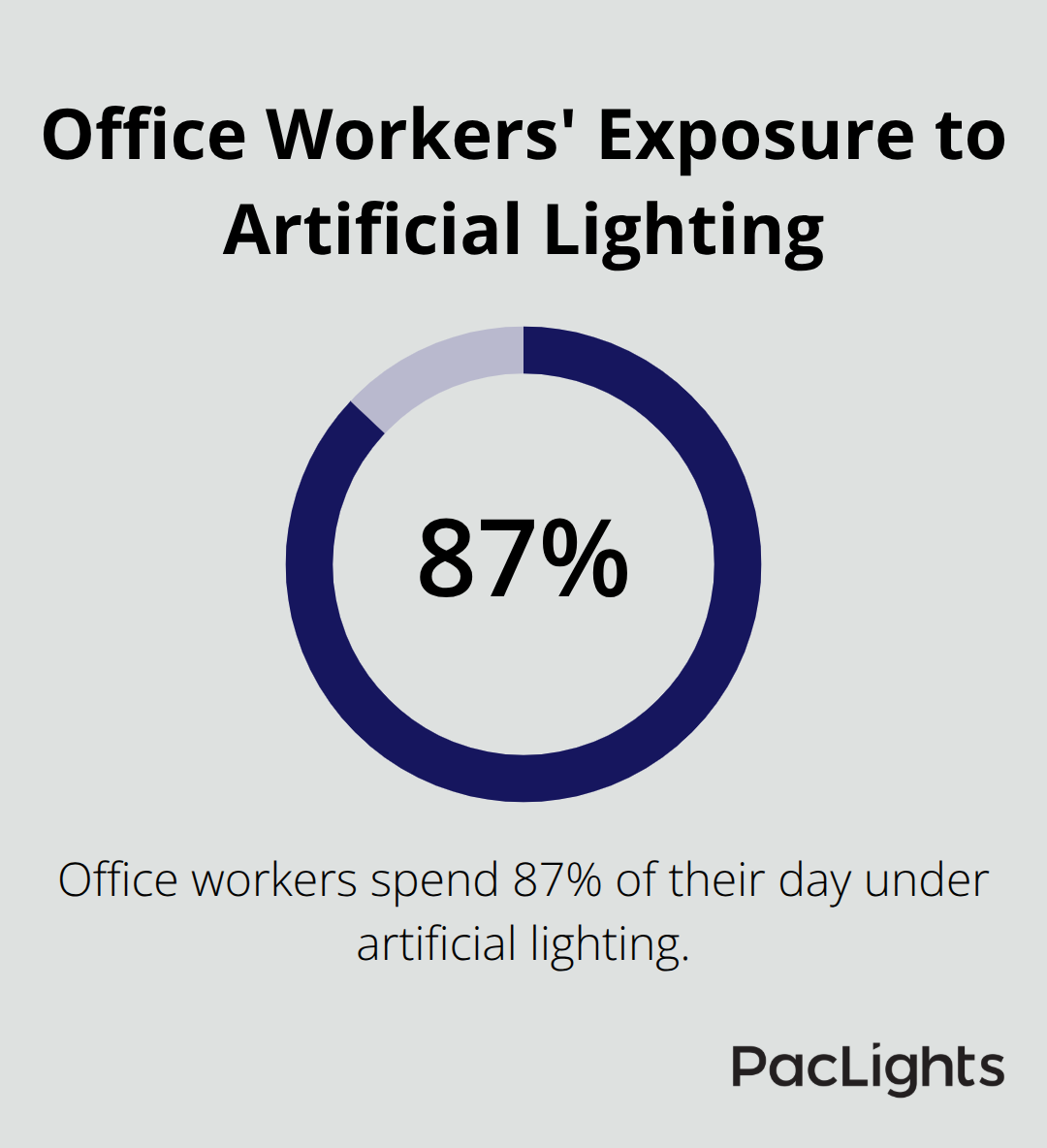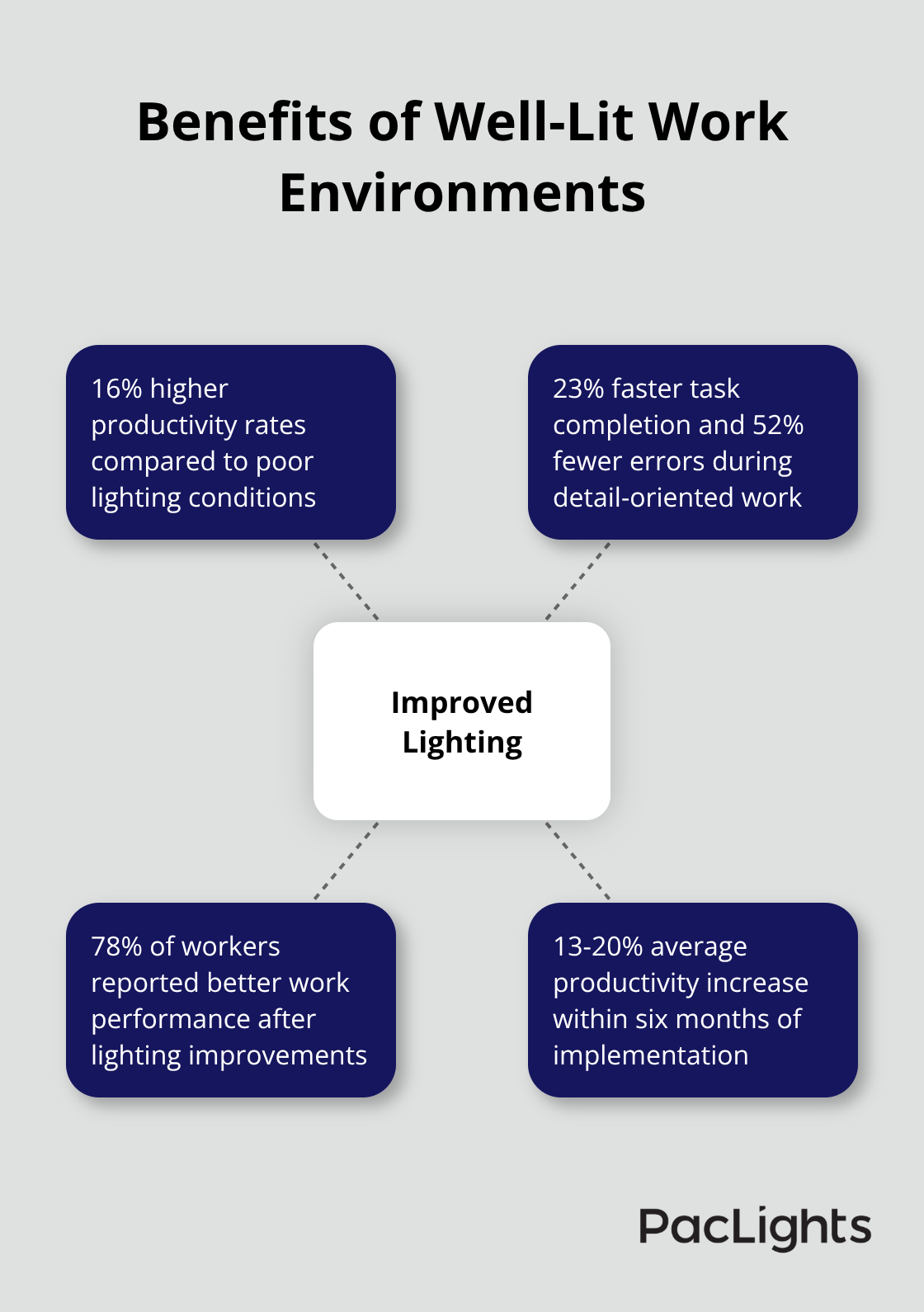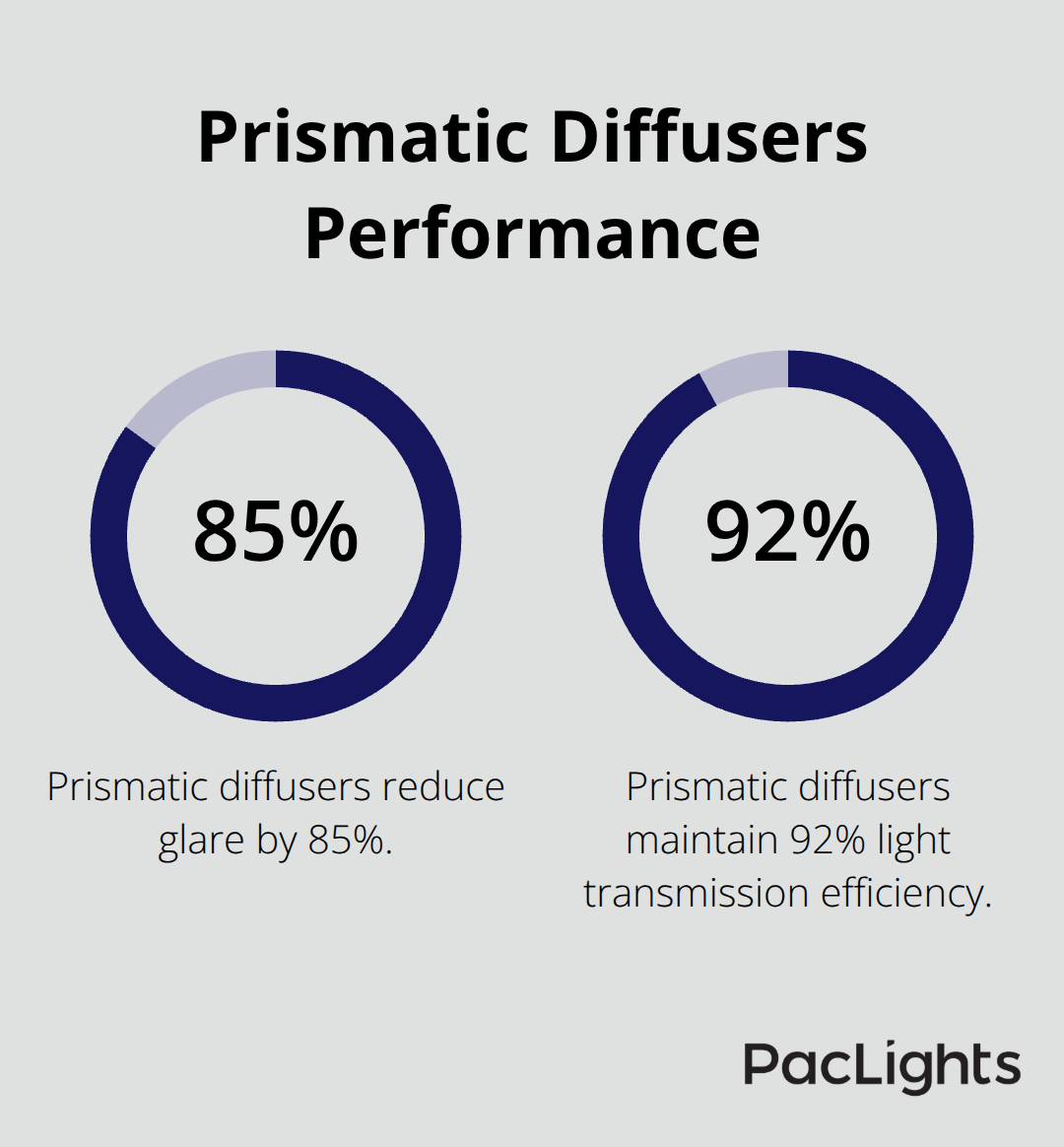Poor lighting affects 68% of office workers daily, leading to headaches, eye strain, and decreased productivity. Office light diffusers transform harsh fluorescent lighting into comfortable, even illumination.
We at PacLights have seen companies reduce employee complaints by 40% after installing quality diffusers. The right lighting solution directly impacts both worker satisfaction and business performance.
How Office Light Diffusers Improve Employee Comfort
Reduce Glare and Eye Strain
Office workers spend 87% of their day under artificial lighting according to the American Optometric Association, which makes proper light diffusion essential for eye health.

Bare fluorescent tubes create harsh direct lighting that forces eyes to constantly adjust, which leads to digital eye strain in 76% of office workers. Light diffusers scatter light rays evenly across surfaces and reduce the contrast between bright fixtures and surrounding areas by up to 60%.
This dramatic reduction prevents the pupil dilation and constriction cycles that cause headaches and fatigue. Workers report 45% fewer eye-related complaints when offices install quality diffusers over existing fixtures. The scattered light approach eliminates the sharp brightness variations that strain visual systems throughout the workday.
Create Even Light Distribution
Standard office lighting without diffusers creates brightness variations of 300-400 lux between different desk areas, which forces employees to struggle with inconsistent working conditions. Professional-grade diffusers distribute light uniformly and maintain consistent illumination levels within 50 lux across entire work surfaces. This even distribution eliminates the dark corners and overly bright spots that force workers to constantly reposition themselves throughout the day.
The Illuminating Engineering Society recommends maintaining 300-500 lux for general office tasks (which becomes achievable only through proper light diffusion). Workers experience 30% better visual comfort when lighting remains consistent across their peripheral vision, which reduces the subconscious stress of working in poorly lit environments.
Minimize Harsh Shadows and Hot Spots
Undiffused lighting creates sharp shadow patterns that shift throughout the day, particularly problematic for computer work where screen glare combines with harsh overhead lighting. Quality diffusers eliminate these concentrated light beams and reduce glare on computer screens by 70% while they maintain adequate task lighting. Hot spots from direct fluorescent exposure can reach 1000+ lux (creating uncomfortable brightness that disrupts concentration and causes squinting).
Diffused lighting maintains optimal contrast ratios between computer screens and surrounding surfaces, which prevents the visual fatigue that affects 90% of workers who use computers for more than three hours daily. These comfort improvements directly translate into measurable productivity gains, which research consistently demonstrates across multiple workplace studies.
The Connection Between Lighting Quality and Workplace Productivity
Research Proves the Productivity Connection
Harvard Business School researchers tracked 21,000 workers across multiple office buildings and found that employees in well-lit environments showed 16% higher productivity rates compared to those under poor lighting conditions. The study measured actual output metrics rather than self-reported satisfaction scores, which makes these findings particularly significant. Northwestern University’s research team documented that workers exposed to optimized lighting completed tasks 23% faster and made 52% fewer errors during detail-oriented work.
The American Society of Interior Designers studied 1,614 office workers and discovered that 78% reported better work performance after lighting improvements. These studies consistently show that proper light diffusion creates measurable business value, not just worker comfort. Companies that invest in quality lighting systems see average productivity increases of 13-20% within the first six months of implementation.

Focus and Concentration Levels Respond Directly to Light Quality
The Journal of Environmental Psychology published research that shows workers under diffused lighting maintained focus for 89 minutes longer during complex tasks compared to those under standard fluorescent lighting. Poor lighting forces the brain to work harder just to process visual information, which depletes cognitive resources needed for actual work tasks. Workers under harsh lighting experience attention lapses every 12-15 minutes, while those with proper diffusion maintain concentration for 45-60 minute periods.
Cornell University’s workplace studies found that employees in offices with quality light diffusers reported 38% better mental clarity and 41% improved decision-making abilities. The research tracked actual work output and found that diffused lighting environments produced 27% more accurate results on analytical tasks. These concentration improvements translate directly into higher quality work and faster project completion times.
Reduced Absenteeism and Health Issues
Companies with poor office lighting report 19% higher absenteeism rates according to the Building Research Establishment’s five-year study of 12,000 workers. Proper lighting reduces headache-related sick days by 63% and eye strain complaints by 84%, which directly impacts staffing consistency and project timelines. The World Health Organization links inadequate workplace lighting to increased stress hormones and sleep disruption (both of which drive higher healthcare costs and reduced performance).
Better lighting reduces the physical stress of visual work, which prevents the muscle tension and fatigue that lead to workplace injuries and medical leave. These health benefits create a foundation for sustained productivity improvements that extend far beyond immediate comfort gains. The right diffuser technology becomes the key factor that determines whether your office lighting supports or undermines employee performance.
Types of Light Diffusers for Commercial Spaces
Prismatic Lens Diffusers for Maximum Light Control
Prismatic diffusers deliver the highest level of light control through precisely engineered micro-prisms that redirect light at optimal angles. These systems reduce glare by 85% while they maintain 92% light transmission efficiency. The micro-prism technology works exceptionally well in offices with high ceilings or intense computer work where precise light direction matters most.
Commercial facilities choose prismatic diffusers when they need maximum performance from their existing fixtures. The engineered prisms eliminate harsh brightness zones that cause eye strain and headaches. Workers report 40% fewer visual complaints when offices install these high-performance diffusers over standard fluorescent fixtures.

Opal Diffusers for Soft Even Illumination
Opal diffusers create the softest illumination through translucent material that scatters light uniformly in all directions. These systems eliminate hot spots completely while they provide consistent 400-500 lux levels across entire work surfaces. The uniform light distribution prevents the brightness variations that force employees to constantly adjust their workspace positions.
Office managers prefer opal diffusers for open floor plans where consistent lighting across large areas becomes essential. The soft light quality reduces visual stress and creates comfortable work environments. These diffusers work particularly well in spaces where workers move frequently between different task areas throughout the day.
Parabolic Louvers for Glare Reduction
Parabolic louvers represent the premium solution for glare control in executive offices and conference rooms where visual comfort directly impacts business outcomes. These systems use angled metal blades that block direct sight lines to light sources while they allow maximum useful light to reach work surfaces. The louver design reduces computer screen glare by 90% compared to standard diffusers.
Installation teams report that parabolic systems solve glare complaints in 95% of problem areas where other diffusers failed. The visual comfort zones extend 40% further from fixtures than other technologies (which makes them ideal for large conference tables and presentation areas). The upfront investment pays back within 18 months through reduced eye strain complaints and measurable productivity gains.
Final Thoughts
Office light diffusers deliver measurable workplace improvements that directly impact business performance. Research shows these systems reduce eye strain complaints by 45% and boost productivity rates by 16%. Workers under quality diffused light maintain focus 89 minutes longer and complete tasks 23% faster than those under harsh fluorescent fixtures.
Companies see return on investment within 18 months through reduced sick days, lower healthcare costs, and increased output quality. Organizations report 40% fewer employee complaints and 13-20% productivity gains within six months of installation. These improvements compound over time as workers experience less visual fatigue and maintain higher performance standards (which creates sustained competitive advantages).
We at PacLights help facilities optimize their work environments through professional assessment and implementation. Start by evaluating your current conditions and identify problem areas where glare or uneven illumination affects workers. Then select the appropriate diffuser technology that matches your specific workspace requirements.


Disclaimer: PacLights is not responsible for any actions taken based on the suggestions and information provided in this article, and readers should consult local building and electrical codes for proper guidance.